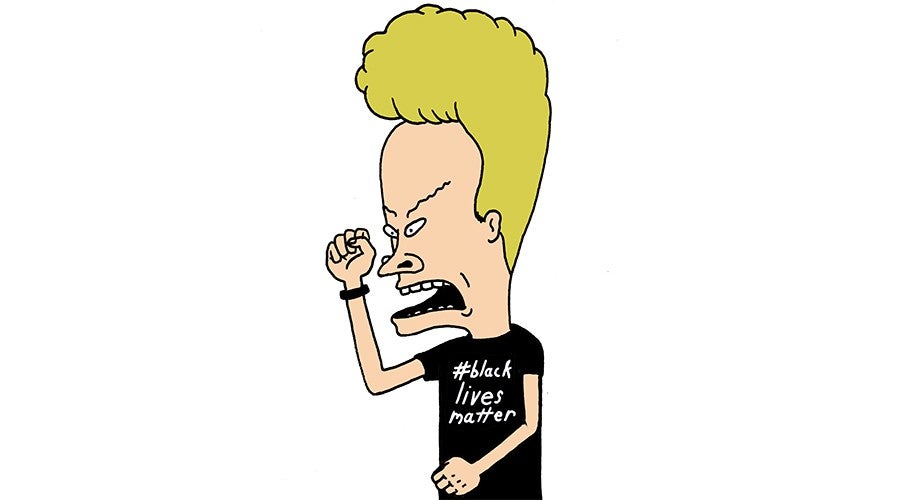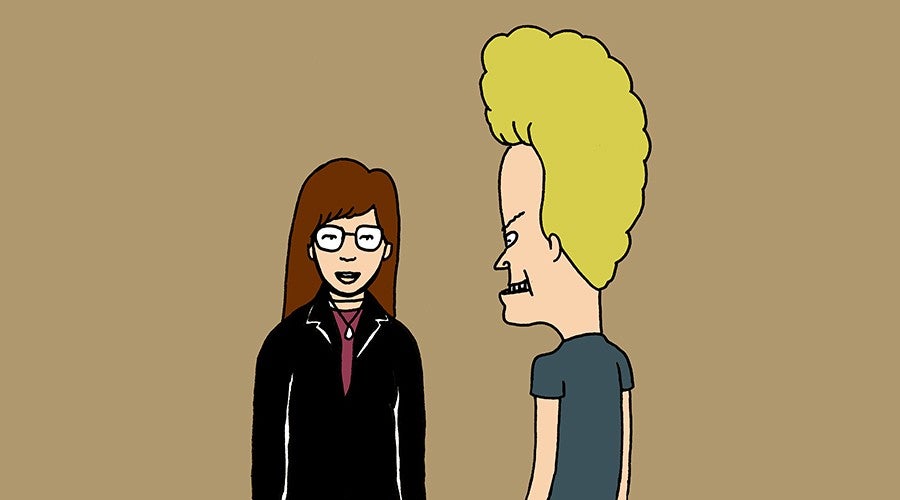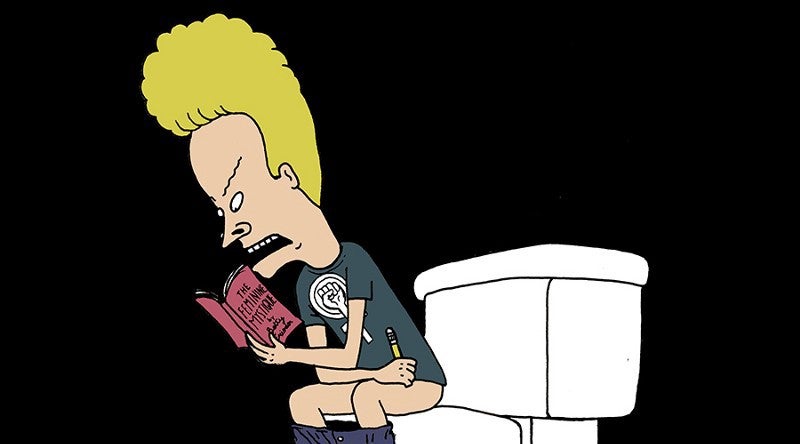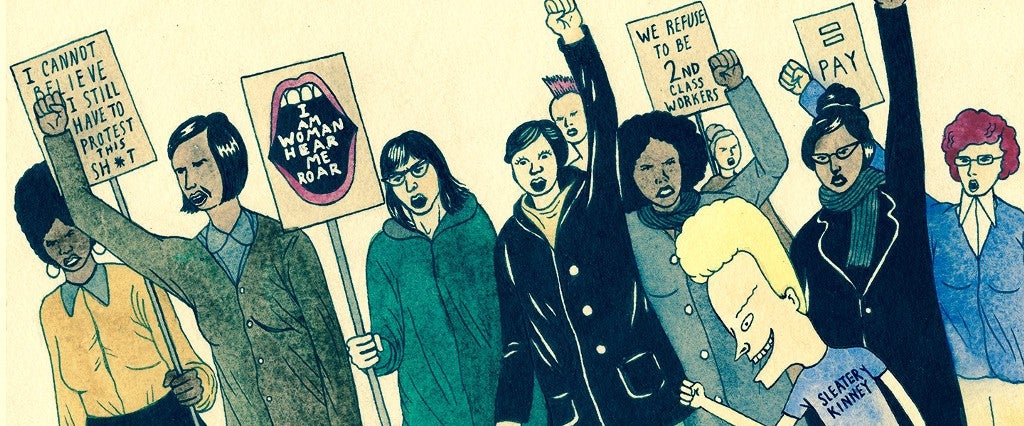As feminist credibility has become a valuable sexual currency for many men, there is increasing suspicion of those who publicly display their intersectional credentials like so much wokeness plumage. Instead of waiting for our own era’s next truly woke bae, we can look to the past in search of male feminist heroes. Though Kurt Cobain, Tupac Shakur and the Beastie Boys all came around to certain feminist principles during their careers, their overt pronouncement of these ideals could appear performative, even opportunistic. But far from the energy of Lollapalooza or the grunge of Seattle, a young man with golden curls and a chuckling disposition was living out a low-key but revolutionary regard for women. His name was Beavis.
While they are often regarded as a single cohesive unit, Beavis and Butt-Head are distinct characters whose differences provide a thematic thread throughout their adventures in High Land. Although the two are guided by the same primary objectives (scoring with chicks, eating nachos, watching television), Butt-Head consistently deploys demanding and ham-handed tactics while courting women. He regularly greets them with a presumptuous, “Hey, baby.” His seduction tactic of choice is dropping his voice an octave, opening his mouth to put his braces on full display, and summoning women with the line, “Come… to Butt-Head.” Beavis, by contrast, pursues women with a respectful open-endedness. His usual greeting is a simple, open-ended “Hey, uh, how’s it goin’?” followed by his signature nervous chuckle — leaving the woman free to lead the conversation.

One classic scene finds the teen rapscallions wandering in the woods, where they happen upon their well-meaning hippie teacher, Mr. Van Driessen, and a group of male friends in a drum circle. Van Driessen explains that the group is for men to share their frustrations in a world of increasingly empowered women, in order to prevent men from taking their aggression out on women. It is what we might today call a “safe space.” While the contrarian Butt-Head declines the invitation to join, Beavis enthusiastically grabs the drum and begins rattling off a litany of his most sordid fantasies, including an elaborate plan to destroy property in his quest to “score.”
These fantasies display how a young man socialized in a patriarchal society becomes frustrated when he is not provided with ample opportunities to score. That he recognizes their danger and utilizes a men’s group to help quell his baser instincts reflects his awareness of the potential toxicity of his own masculinity, and his desire to attain a more enlightened state.
Beavis is also notorious for his love of dancing, frequently surrendering to the beat in a move similar to twerking — though frequently performed on the side of the couch rather than on a dance floor. Of course, dancing is not a feminist act in and of itself, but Beavis dances alone and with reckless abandon, knowing he is not emasculated by his own emotional connection to music — despite admonitions and occasional violence from Butt-Head pressuring him to conform to a rigid code of masculinity whereby headbanging is the only acceptable way to signal one’s approval of music.

Though Beavis is admonished by Butt-head and critics alike for his unwieldy sexual energy and his uncontrollable submission to the rhythm when it strikes, it is notable that he never touches the women to whom he is attracted. While Butt-head reaches out his hands suggestively and directly summons women, Beavis never attempts physical contact. That his mouth falls agape, his eyes open wide, and he is rendered speechless are forgivable when you consider that his failure to bang chicks is always recognized as a personal fault. And while Beavis’ main priority in life is to score, he never responds to rejection with disdain for the women who decline his offer of coitus — rather he experiences personal grief characterized by low-decibel lamentation and occasional panic that he might never score.
Beavis is unwavering in his support of sex workers, speaking of them without any attendant stigma or moralizing. When Mr. Van Driessen calls on Beavis to present on the woman he most admires for Women’s History Month, he declares, “Uh, my mom.” Followers of the program are familiar with the fact that Beavis’ mother, who does not appear on screen, is a sex worker. When Butt-Head attempts to mock him for this, Beavis speaks matter-of-factly of her wages rather than distancing himself from the very labor that keeps him in nachos, cable, and short shorts.
In the feature film Beavis & Butt-Head Do America, the boys are mistaken for two hitmen by a low-level mobster and instructed to “do his wife” (meaning kill her) for money, they agree, essentially agreeing to become sex workers themselves. When the wife in question instructs them to turn around and “do” her husband instead at a higher fee, the boys once again think she means engage in coitus. Butt-Head flatly refuses, but Beavis takes a practical approach, noting that there is a considerable sum of money at hand; he makes no homophobic or misogynistic remarks.

When Beavis and Butt-Head come across a bellicose Christian protester outside of a women’s clinic yelling “Whores! Fornicators!,” the boys mistake his cries as indications that he is promoting a brothel rather than protesting abortion. Beavis responds, “I’ve always thought there should be a whorehouse here!” He has little regard for NIMBY laws that would penalize working women and drive their workplaces to the outskirts of town.

Later in the episode, the boys become trapped in an elevator with an attractive woman. In her frustration with their inability to help her escape through the roof, she asks, “Do you want to have sex?” in an attempt to get them in a position that will enable her to step on their backs to get out on her own. But before the ruse can be completed, Beavis replies, “Yeah, if it’s not too much trouble!” Beavis has spent much of his life trying and failing to score, but this does not prevent him from seeking enthusiastic consent.
That the name “Beavis” means “handsome face” in French was perhaps a cruel gesture by the hand of creator Mike Judge. Or perhaps it was meant to point to the beauty inside Beavis, hovering as it did just below the surface. Moving just one letter of his name, one gets “Baevis,” or rather “Bae: vis.” The slang term for a beloved accompanied by the French command to live is not a description of Beavis himself, but his instruction to those he has pined after for so long: chicks. As is his custom, he addresses them with a term of endearment and implores them to live freely, to do as they please.
That — as Beavis himself would say — is pretty cool.
